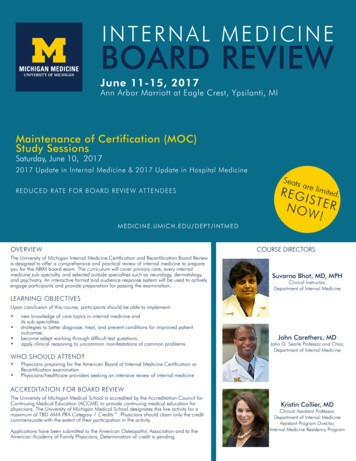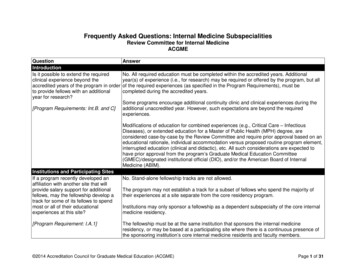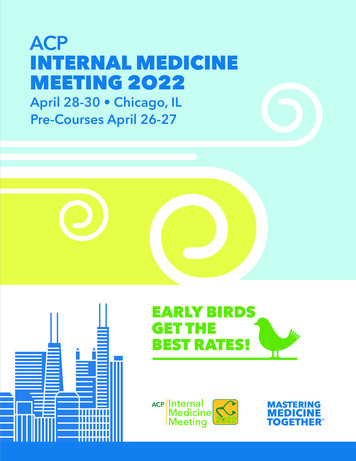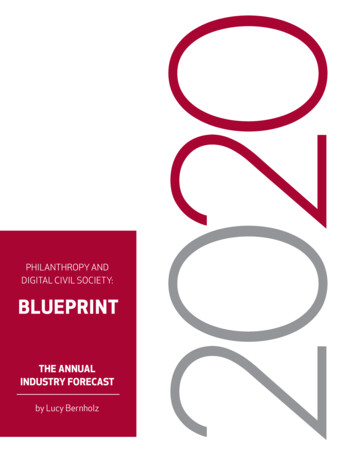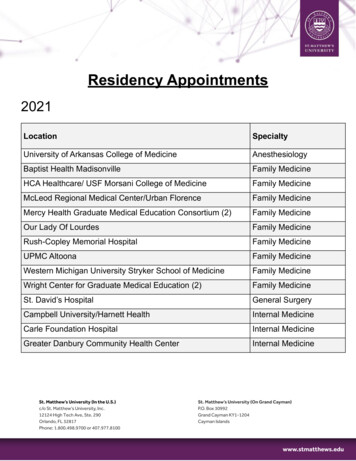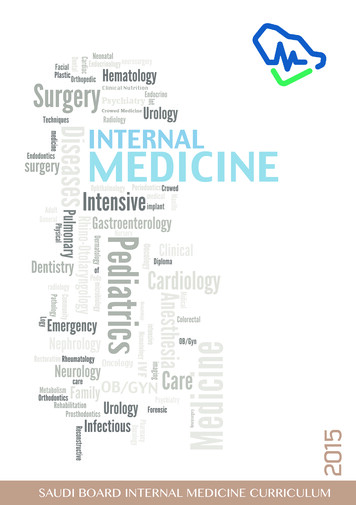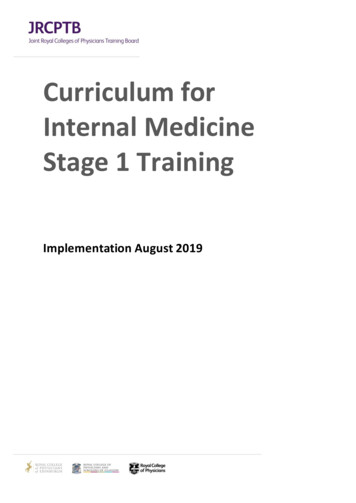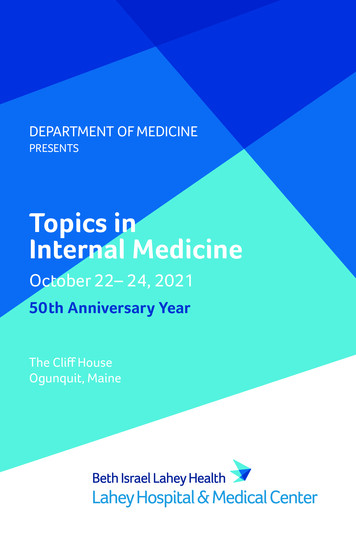
Transcription
INTERNAL MEDICINE BlueprintFor traditional, 10-year Maintenance of Certification (MOC) exam and Longitudinal Knowledge Assessment (LKA )ABIM invites diplomates to help develop theInternal Medicine MOC blueprintPurpose of the Internal Medicine MOCAssessmentsBased on feedback from physicians that MOC assessmentsshould better reflect what they see in practice, in 2015 theAmerican Board of Internal Medicine (ABIM) invited certifiedgeneral internists to provide ratings of the relative frequencyand importance of blueprint topics in practice.MOC assessments are designed to evaluate whether a certifiedinternist has maintained competence and currency in theknowledge and judgment required for practice. The MOCassessments emphasizes diagnosis and management ofprevalent conditions, particularly in areas where practice haschanged in recent years. As a result of the blueprint review byABIM diplomates, the assessments place less emphasis on rareconditions and focuses more on situations in which physicianintervention can have important consequences for patients.For conditions that are usually managed by other specialists,the focus is on recognition rather than on management.This review process, which resulted in a new MOC examblueprint, will be used on a periodic basis to inform and updateall MOC assessments created by ABIM. No matter what formABIM’s assessments ultimately take, they will need to beinformed by front-line clinicians sharing their perspective onwhat is important to know.A sample of over 300 physicians, similar to the total invitedpopulation of internists in age, time spent in direct patient care,and practice setting, provided the blueprint topic ratings. ABIMused this feedback to update the blueprint for MOC assessments(beginning with the Fall 2015 administration of the traditional,10-year MOC exam).To inform how assessment content should be distributed acrossthe major blueprint content categories, ABIM considered theaverage respondent ratings of topic frequency and importancein each of the content categories. A second source of informationwas the relative frequency of patient conditions in the contentcategories, as seen by certified Internists and documentedby national health care data (described further under Contentdistribution below).To determine prioritization of specific exam content within eachmajor medical content category, ABIM used the respondentratings of topic frequency and importance to set thresholds forthese parameters in the exam assembly process (describedfurther under Detailed content outline below).Assessment formatThe traditional, 10-year MOC exam comprises up to 220 singlebest-answer multiple-choice questions, of which approximately50 are new questions that do not count in the examinee’s score.Examinees taking the MOC exam will have access to an externalresource (i.e., UpToDate ) for the entire exam.The LKA for MOC is a five-year cycle in which physicians answerquestions on an ongoing basis and receive feedback on howthey’re performing along the way. More information on howassessments are developed can be found at spx.Most questions describe clinical scenarios and ask about thework done (that is, tasks performed) by physicians in the courseof practice: Diagnosis: making a diagnosis or identifying anunderlying condition Testing: ordering tests for diagnosis, staging, or follow-up Treatment/Care Decisions: recommending treatmentor other patient care Risk Assessment/Prognosis/Epidemiology: assessingrisk, determining prognosis, and applying principles fromepidemiologic studies Pathophysiology/Basic Science: understanding thepathophysiology of disease and basic science knowledgeapplicable to patient careJANUARY 20221
Reflecting the overall predominance of office-based internalmedicine practice, most questions describe patient encountersthat take place in outpatient settings; some encounters willoccur in hospital or other inpatient settings as most generalinternists provide patient care in these settings as well.Clinical information presented may include patient photographs,radiographs, electrocardiograms, and other media to illustraterelevant patient findings.Exam tutorials, including examples of ABIM assessment questionformat, can be found at tion/internal-medicine/exam-tutorial.aspx.Content distributionListed below are the major medical content categories thatdefine the domain for the Internal Medicine traditional, 10-yearMOC exam and LKA. The relative distribution of contentis expressed as a percentage of the total assessment. Todetermine the content distribution, ABIM considered theaverage respondent ratings of topic frequency and importanceMEDICAL CONTENT CATEGORYTarget %To cross-validate these self-reported ratings, ABIM alsoconsidered the relative frequency of conditions seen in patientsfrom the National Ambulatory Medical Care Survey (NAMCS)and the National Hospital Discharge Survey (NHDS) by acohort of certified internists. Informed by these data, theInternal Medicine Approval Committee and Internal MedicineBoard have established the content category targets.The Internal Medicine MOC assessments may cover otherdimensions of medicine as applicable to the medical contentcategories, such as critical care medicine, preventive medicine,women’s health, clinical epidemiology, ethics, nutrition, palliativeand end-of-life care, occupational medicine, patient safety,and substance use disorders.How the blueprint ratings are used to assemblethe MOC assessmentsBlueprint reviewers provided ratings of relative frequency inpractice for each of the detailed content topics in the blueprintand provided ratings of the relative importance of the topicsfor each of the tasks described in Assessment format above.In rating importance, reviewers were asked to consider factorssuch as the following: High risk of a significant adverse outcomeAllergy and Immunology2% Cost of care and stewardship of resourcesCardiovascular15% Common errors in diagnosis or managementDermatology3% Effect on population healthEndocrinology, Diabetes, and Metabolism10% Effect on quality of lifeGastroenterology10%Geriatric Syndromes3% When failure to intervene by the physician deprivesa patient of significant benefitHematology4%Infectious Disease10%Medical Oncology6%Miscellaneous1%Nephrology and Urology6%Neurology4%Obstetrics and Gynecology3%Ophthalmology1%Otolaryngology and Dental Medicine1%Psychiatry3%Pulmonary Disease8%Rheumatology and Orthopedics10%TotalJANUARY 2022Frequency and importance were rated on a three-point scalecorresponding to low, medium, or high. The median importanceratings are reflected in the Detailed content outline below.The Internal Medicine Approval Committee and Internal MedicineBoard, in partnership with the physician community, have setthe following parameters for selecting MOC assessmentquestions according to the blueprint review ratings: At least 75% of questions will address high-importancecontent (indicated in green) No more than 25% of questions will address mediumimportance content (indicated in yellow) No questions will address low-importance content(indicated in red)Independent of the importance and task ratings, no more than18% of questions will address low-frequency content (indicatedby “LF” following the topic description).100%2
The content selection priorities below are subject to change in response to future blueprint review.Note: The same topic may appear in more than one medical content category.Detailed Content Outline for the Internal Medicine traditional, 10-year MOC exam and the LKA–H igh Importance: At least 75% of questionswill address topics and tasks with thisdesignation.–M edium Importance: No more than 25%of questions will address topics and taskswith this designation.–L ow Importance: No questions willaddress topics and tasks withthis designation.LF – Low Frequency: No more than 18% of questions will address topics with this designation, regardless of task or importance.ALLERGY AND IMMUNOLOGY(2% of exam)DiagnosisTestingTreatment/Care DecisionsRisk asic ScienceANAPHYLAXIS ( 2% of exam)Aspirin idiosyncrasyLFStinging insect hypersensitivityDesensitization therapyLFSerum sickness*Undifferentiated anaphylaxis*ASTHMA ( 2% of exam)Exercise- and cold-induced asthmaAllergic bronchopulmonaryaspergillosisLFNasal polyps and aspirin sensitivityOccupational asthmaAsthma and pregnancyLFAsthma mimics (including vocalcord dysfunction)LFUndifferentiated asthmaRHINITIS/SINUSITIS/CONJUNCTIVITIS ( 2% of exam)Allergic rhinitisAcute and chronic sinusitisAllergic conjunctivitisUpper airway cough syndromeJANUARY 2022*This topic was added or revised after the blueprint was reviewed by Internal Medicine diplomates; it has beenprovisionally rated by the Internal Medicine Approval Committee, pending the next blueprint review process.3
–H igh Importance: At least 75% of questionswill address topics and tasks with thisdesignation.–M edium Importance: No more than 25%of questions will address topics and taskswith this designation.–L ow Importance: No questions willaddress topics and tasks withthis designation.LF – Low Frequency: No more than 18% of questions will address topics with this designation, regardless of task or importance.ALLERGY AND IMMUNOLOGYcontinued (2% of exam)DiagnosisTestingTreatment/Care DecisionsRisk asic ScienceFOOD ALLERGY ( 2% of exam)Food allergyURTICARIA AND ANGIOEDEMA ( 2% of exam)Hereditary angioedemaLFDrug-induced urticaria andangioedemaTransfusion-related urticariaor anaphylaxisContrast-related allergySKIN DISORDERS ( 2% of exam)Atopic dermatitisContact dermatitisDRUG ALLERGY OTHER THAN DRUG-INDUCED URTICARIA AND ANGIOEDEMA ( 2% of exam)Drug allergy other than druginduced urticaria and angioedemaLFPRIMARY IMMUNODEFICIENCY DISORDERS ( 2% of exam)Antibody deficiency (commonvariable immunodeficiency)LFCellular immunodeficiency otherthan human immunodeficiencyvirus (HIV) infectionLFComplement deficiencyLFPrimary humoral immunodeficiency*ALLERGIC COMPLICATIONS OF TRANSFUSIONS ( 2% of exam)Hemolytic transfusion reactionsLFTransfusion-related acute lung injuryLFTransfusion-related urticariaand anaphylaxisLFJANUARY 2022*This topic was added or revised after the blueprint was reviewed by Internal Medicine diplomates; it has beenprovisionally rated by the Internal Medicine Approval Committee, pending the next blueprint review process.4
–H igh Importance: At least 75% of questionswill address topics and tasks with thisdesignation.–M edium Importance: No more than 25%of questions will address topics and taskswith this designation.–L ow Importance: No questions willaddress topics and tasks withthis designation.LF – Low Frequency: No more than 18% of questions will address topics with this designation, regardless of task or importance.ALLERGY AND IMMUNOLOGYcontinued (2% of exam)DiagnosisTestingTreatment/Care DecisionsRisk asic ScienceRisk asic ScienceAUTOIMMUNE SYSTEMIC DISORDERS (INCLUDING IgG4-RELATED DISORDER) ( 2% of exam)MastocytosisLFAllergic interstitial nephritisLFEosinophilic esophagitisLFEosinophilic pneumoniaLFEosinophilic granulomatosiswith polyangiitis (Churg-Strausssyndrome)LFHypersensitivity pneumonitis(extrinsic allergic alveolitis)LFCARDIOVASCULAR DISEASE(15% of exam)DiagnosisTestingTreatment/Care DecisionsHYPERTENSION (5% of exam)NOTE: This total includes the Hypertension content listed under Endocrinology, Diabetes, and Metabolism and Nephrology and UrologyEssential hypertensionRenal (including renal parenchymaland renovascular)Coarctation of the aortaLFHypertensive urgency andemergencyUndifferentiated hypertensionPERICARDIAL DISEASE ( 2% of exam)PericarditisLFPericardial effusionLFConstrictive pericarditisLFISCHEMIC HEART DISEASE ( 2% of exam)Stable angina pectorisAcute coronary syndrome (ACS)ACS complicationsJANUARY 2022*This topic was added or revised after the blueprint was reviewed by Internal Medicine diplomates; it has beenprovisionally rated by the Internal Medicine Approval Committee, pending the next blueprint review process.5
–H igh Importance: At least 75% of questionswill address topics and tasks with thisdesignation.–M edium Importance: No more than 25%of questions will address topics and taskswith this designation.–L ow Importance: No questions willaddress topics and tasks withthis designation.LF – Low Frequency: No more than 18% of questions will address topics with this designation, regardless of task or importance.CARDIOVASCULAR DISEASEcontinued (15% of exam)DiagnosisTestingTreatment/Care DecisionsRisk asic ScienceISCHEMIC HEART DISEASE continued ( 2% of exam)Heart failure from ischemiccardiomyopathyEvaluation of undiagnosedchest painOther ischemic heart diseaseLF(coronary artery disease and spasm)DYSRHYTHMIAS AND CONDUCTION DEFECTS ( 2% of exam)Conduction defectsBradyarrhythmiasTachyarrhythmiasOther dysrhythmias (cardiacresuscitation)*CONGENITAL HEART DISEASE IN ADULTS ( 2% of exam)Atrial septal defect and patentforamen ovaleLFBicuspid aortic valveLFOther congenital heart disease(patent ductus arteriosus, ventricularseptal defect, pulmonic stenosis)LFVALVULAR HEART DISEASE ( 2% of exam)Aortic stenosisAortic regurgitationMitral regurgitationMitral stenosisLFProsthetic heart valveMYOCARDIAL DISEASE ( 2% of exam)Heart failure with preservedejection fraction (HFpEF)MyocarditisLFHypertrophic cardiomyopathy withand without obstructionLFJANUARY 2022*This topic was added or revised after the blueprint was reviewed by Internal Medicine diplomates; it has beenprovisionally rated by the Internal Medicine Approval Committee, pending the next blueprint review process.6
–H igh Importance: At least 75% of questionswill address topics and tasks with thisdesignation.–M edium Importance: No more than 25%of questions will address topics and taskswith this designation.–L ow Importance: No questions willaddress topics and tasks withthis designation.LF – Low Frequency: No more than 18% of questions will address topics with this designation, regardless of task or importance.CARDIOVASCULAR DISEASEcontinued (15% of exam)DiagnosisTestingTreatment/Care DecisionsRisk asic ScienceMYOCARDIAL DISEASE ( 2% of exam)Restrictive cardiomyopathyLFDilated cardiomyopathyLFCor pulmonaleUndifferentiated myocardial disease*ENDOCARDITIS AND OTHER CARDIOVASCULAR INFECTION ( 2% of exam)EndocarditisLFInfections of the pericardial spaceLFEndocarditis prophylaxisUndifferentiated cardiovascularinfection*VASCULAR DISEASE ( 2% of exam)Carotid artery diseaseAortaPeripheral arterial diseasePulmonary vascular diseaseVenous disease of the lowerextremitiesSuperior vena cava syndrome(not due to cancer)LFSYNCOPE ( 2% of exam)Neurocardiogenic syncope(vasovagal syncope)Situational syncope (including coughsyncope and micturition syncope)Postural hypotensionJANUARY 2022*This topic was added or revised after the blueprint was reviewed by Internal Medicine diplomates; it has beenprovisionally rated by the Internal Medicine Approval Committee, pending the next blueprint review process.7
–H igh Importance: At least 75% of questionswill address topics and tasks with thisdesignation.–M edium Importance: No more than 25%of questions will address topics and taskswith this designation.–L ow Importance: No questions willaddress topics and tasks withthis designation.LF – Low Frequency: No more than 18% of questions will address topics with this designation, regardless of task or importance.CARDIOVASCULAR DISEASEcontinued (15% of exam)DiagnosisTestingTreatment/Care DecisionsRisk asic SciencePREOPERATIVE CONSULTATION ( 2% of exam)No testing requiredTesting indicatedLIPID DISORDERS ( 2% of exam)Lipid disordersANTITHROMBOTIC THERAPY IN CARDIOVASCULAR DISEASE ( 2% of exam)Antithrombotic therapy incardiovascular diseaseMISCELLANEOUS CARDIOVASCULAR DISEASE (PHYSICAL EXAMINATION FINDINGS, MURMURS) ( 2% of exam)Miscellaneous cardiovasculardisease (physical examinationfindings, murmurs)LFDERMATOLOGY(3% of exam)DiagnosisTestingTreatment/Care DecisionsRisk asic ScienceDERMATITIS (ECZEMAS) ( 2% of exam)Atopic dermatitisContact dermatitisPhotodermatitisLFStasis dermatitisHand dermatitisDrug eruptionsNummular dermatitisLFExfoliative dermatitis (erythroderma,not including mycosis fungoides)LFSeborrheic dermatitisDERMATOLOGIC IMMUNOLOGY ( 2% of exam)Urticaria and angioedemaLeukocytoclastic vasculitisJANUARY 2022LF*This topic was added or revised after the blueprint was reviewed by Internal Medicine diplomates; it has beenprovisionally rated by the Internal Medicine Approval Committee, pending the next blueprint review process.8
–H igh Importance: At least 75% of questionswill address topics and tasks with thisdesignation.–M edium Importance: No more than 25%of questions will address topics and taskswith this designation.–L ow Importance: No questions willaddress topics and tasks withthis designation.LF – Low Frequency: No more than 18% of questions will address topics with this designation, regardless of task or importance.DERMATOLOGY continued (3% of exam)DiagnosisTestingTreatment/Care DecisionsRisk asic ScienceVASCULAR DERMATOSES ( 2% of exam)Erythema multiformeLFErythema nodosumLFTelangiectasiaLeg ulcersACNE AND ROSACEA ( 2% of exam)Acne vulgarisRosaceaPAPULOSQUAMOUS DERMATOSES ( 2% of exam)PsoriasisPityriasis roseaLFLichen planusLFSKIN AND SOFT TISSUE INFECTIONS ( 2% of exam)DermatophytesHerpes zoster and varicellaViral exanthems other than varicella LFCellulitisNecrotizing soft tissue infectionsand gas gangreneLFLymphadenitis and lymphangitisLFEctoparasites (lice, scabies,and others)LFVESICULOBULLOUS DERMATOSES ( 2% of exam)Pemphigus vulgarisLFDermatitis herpetiformisLFJANUARY 2022*This topic was added or revised after the blueprint was reviewed by Internal Medicine diplomates; it has beenprovisionally rated by the Internal Medicine Approval Committee, pending the next blueprint review process.9
–M edium Importance: No more than 25%of questions will address topics and taskswith this designation.–H igh Importance: At least 75% of questionswill address topics and tasks with thisdesignation.–L ow Importance: No questions willaddress topics and tasks withthis designation.LF – Low Frequency: No more than 18% of questions will address topics with this designation, regardless of task or importance.DERMATOLOGY continued (3% of exam)DiagnosisTestingTreatment/Care DecisionsRisk asic SciencePIGMENT DISORDERS ( 2% of exam)Vitiligo and other hypopigmentationLFdisordersMelasma (chloasma)LFAcanthosis nigricansLFXeroderma pigmentosa*PHOTOSENSITIVITY DERMATOSES ( 2% of exam)Porphyria cutanea tardaLFPhotodermatitisALOPECIA ( 2% of exam)AlopeciaNODULES AND TUMORS OF THE SKIN ( 2% of exam)Seborrheic keratosisActinic keratosisWarts, corns and skin tagsSquamous cell carcinoma of the skinBasal cell carcinoma of the skinMelanoma and neviMycosis fungoidesLFOther nodules and tumors of theskin (dermatofibroma)*NUTRITIONAL DISORDERS, CUTANEOUS MANIFESTATIONS ( 2% of exam)Vitamin C deficiency and scurvyLFNiacin deficiency*Other nutritional disorders of skin*DISORDERS OF THE NAILS ( 2% of exam)Disorders of the nailsJANUARY 2022*This topic was added or revised after the blueprint was reviewed by Internal Medicine diplomates; it has beenprovisionally rated by the Internal Medicine Approval Committee, pending the next blueprint review process.10
–M edium Importance: No more than 25%of questions will address topics and taskswith this designation.–H igh Importance: At least 75% of questionswill address topics and tasks with thisdesignation.–L ow Importance: No questions willaddress topics and tasks withthis designation.LF – Low Frequency: No more than 18% of questions will address topics with this designation, regardless of task or importance.DERMATOLOGY continued (3% of exam)DiagnosisTestingTreatment/Care DecisionsRisk asic ScienceTestingTreatment/Care DecisionsRisk asic ScienceENVIRONMENTAL INJURY OF SKIN ( 2% of exam)FrostbiteLFBurnsLFPRESSURE INJURIES ( 2% of exam)Pressure injuriesUndifferentiated dermatology*ENDOCRINOLOGY, DIABETES,AND METABOLISM(10% of exam)DiagnosisADRENAL DISORDERS ( 2% of exam)Primary aldosteronism andmineralocorticoid excessLFAdrenal insufficiencyLFPheochromocytomaLFTHYROID DISORDERS ( 2% of exam)HyperthyroidismHypothyroidismThyroiditis (not Hashimoto’sor peripartum)LFThyroid nodules and thyroid cancerEuthyroid sick syndromeThyroid storm*HYPERTENSION (5% of exam)NOTE: This total includes the Hypertension content listed under Cardiovascular Disease and Nephrology and UrologyEssential hypertensionRenal artery stenosisLFCushing’s diseaseLFJANUARY 2022*This topic was added or revised after the blueprint was reviewed by Internal Medicine diplomates; it has beenprovisionally rated by the Internal Medicine Approval Committee, pending the next blueprint review process.11
–H igh Importance: At least 75% of questionswill address topics and tasks with thisdesignation.–M edium Importance: No more than 25%of questions will address topics and taskswith this designation.–L ow Importance: No questions willaddress topics and tasks withthis designation.LF – Low Frequency: No more than 18% of questions will address topics with this designation, regardless of task or importance.ENDOCRINOLOGY, DIABETES,AND METABOLISM continued (10% of exam)DiagnosisTestingTreatment/Care DecisionsRisk asic ScienceLIPID DISORDERS ( 2% of exam)HypercholesterolemiaHypertriglyceridemia (not includingchylomicronemia)Chylomicronemia syndromeLFDiet and hyperlipidemiaOVARIAN DISORDERS AND FEMALE REPRODUCTIVE HEALTH ( 2% of exam)Polycystic ovary syndromeAmenorrheaLFOvarian cancerLFTESTES AND MALE REPRODUCTIVE HEALTH ( 2% of exam)Male hypogonadismMale infertilityLFErectile dysfunctionTesticular carcinoma/tumorsLFGynecomastia*DIABETES MELLITUS ( 2% of exam)Type 1 diabetes mellitusType 2 diabetes mellitusDiabetes mellitus and pregnancyLFComplications of diabetes mellitusDISORDERS OF CALCIUM METABOLISM AND BONE ( 2% of exam)HypercalcemiaHypocalcemia (not includingvitamin D JANUARY 2022*This topic was added or revised after the blueprint was reviewed by Internal Medicine diplomates; it has beenprovisionally rated by the Internal Medicine Approval Committee, pending the next blueprint review process.12
–M edium Importance: No more than 25%of questions will address topics and taskswith this designation.–H igh Importance: At least 75% of questionswill address topics and tasks with thisdesignation.–L ow Importance: No questions willaddress topics and tasks withthis designation.LF – Low Frequency: No more than 18% of questions will address topics with this designation, regardless of task or importance.ENDOCRINOLOGY, DIABETES,AND METABOLISM continued (10% of exam)DiagnosisTestingTreatment/Care DecisionsRisk asic ScienceDISORDERS OF CALCIUM METABOLISM AND BONE continued ( 2% of exam)Paget’s diseaseLFOsteoporosisVitamin D deficiency andosteomalaciaRenal osteodystrophyLFHYPOTHALAMIC DISORDERS ( 2% of exam)Hypothalamic disordersLFANTERIOR PITUITARY DISORDERS ( 2% of exam)Pituitary tumorsLFHypopituitarismLFPOSTERIOR PITUITARY DISORDERS AND WATER HOMEOSTASIS ( 2% of exam)HypernatremiaHyponatremiaENDOCRINE TUMORS AND ENDOCRINE MANIFESTATIONS OF TUMORS ( 2% of exam)InsulinomaLFVasoactive intestinal peptide(VIP)-secreting tumorsLFZollinger-Ellison syndrome(gastrinoma)LFGlucagon-secreting tumorsLFCarcinoid pic adrenocorticotropichormone (ACTH) due to tumorLFSIADH from tumorLFUndifferentiated endocrine tumorsor manifestations of tumors*JANUARY 2022*This topic was added or revised after the blueprint was reviewed by Internal Medicine diplomates; it has beenprovisionally rated by the Internal Medicine Approval Committee, pending the next blueprint review process.13
–H igh Importance: At least 75% of questionswill address topics and tasks with thisdesignation.–M edium Importance: No more than 25%of questions will address topics and taskswith this designation.–L ow Importance: No questions willaddress topics and tasks withthis designation.LF – Low Frequency: No more than 18% of questions will address topics with this designation, regardless of task or importance.ENDOCRINOLOGY, DIABETES,AND METABOLISM continued (10% of exam)DiagnosisTestingTreatment/Care DecisionsRisk asic ScienceTestingTreatment/Care DecisionsRisk asic ScienceHYPOGLYCEMIA NOT DUE TO INSULINOMA ( 2% of exam)Hypoglycemia not due to insulinomaPOLYGLANDULAR AUTOIMMUNE DISORDERS ( 2% of exam)Multiple endocrine hypofunctionLFNUTRITIONAL DISORDERS ( 2% of exam)ObesityParenteral nutritionLFUndifferentiated nutritional disorders*WOMEN’S HEALTH ENDOCRINE ISSUES ( 2% of exam)Women’s health endocrine issuesGASTROENTEROLOGY(10% of exam)DiagnosisESOPHAGEAL DISEASE ( 2% of exam)Gastroesophageal refluxBarrett’s esophagusEsophageal carcinomaLFEsophageal motility disordersMedication-induced esophagealdisorderEsophageal diverticulaLFEsophageal strictures and websGastroesophageal varicesJANUARY 2022*This topic was added or revised after the blueprint was reviewed by Internal Medicine diplomates; it has beenprovisionally rated by the Internal Medicine Approval Committee, pending the next blueprint review process.14
–H igh Importance: At least 75% of questionswill address topics and tasks with thisdesignation.–M edium Importance: No more than 25%of questions will address topics and taskswith this designation.–L ow Importance: No questions willaddress topics and tasks withthis designation.LF – Low Frequency: No more than 18% of questions will address topics with this designation, regardless of task or importance.GASTROENTEROLOGY continued (10% of exam)DiagnosisTestingTreatment/Care DecisionsRisk asic ScienceESOPHAGEAL DISEASE continued ( 2% of exam)Infectious esophagitis(Candida, herpes simplex virus,cytomegalovirus)LFMallory-Weiss syndromeLFOther esophageal disease(eosinophilic esophagitis,esophageal rupture)LFSTOMACH AND DUODENAL DISEASE ( 2% of exam)Helicobacter pylori infectionPeptic ulcer disease other thanHelicobacter pylori infectionGastritis and gastropathyStomach cancerLFNonulcer dyspepsiaDisorders of gastric emptyingMenetrier’s disease*SMALL INTESTINAL DISEASE ( 2% of exam)Celiac diseaseLFBacterial overgrowth syndromeLFShort bowel syndromeLFIschemic bowel diseaseCrohn’s disease including Crohn’scolitisGastroenteritis other than antibioticcolitisOther small intestinal disease(diarrhea [osmotic, post-surgical,bile salt-induced, nocturnal], gastricbypass complications)JANUARY 2022LF*This topic was added or revised after the blueprint was reviewed by Internal Medicine diplomates; it has beenprovisionally rated by the Internal Medicine Approval Committee, pending the next blueprint review process.15
–H igh Importance: At least 75% of questionswill address topics and tasks with thisdesignation.–M edium Importance: No more than 25%of questions will address topics and taskswith this designation.–L ow Importance: No questions willaddress topics and tasks withthis designation.LF – Low Frequency: No more than 18% of questions will address topics with this designation, regardless of task or importance.GASTROENTEROLOGY continued (10% of exam)DiagnosisTestingTreatment/Care DecisionsRisk asic ScienceCOLONIC AND ANORECTAL DISEASE ( 2% of exam)Colorectal cancerColon polyposis syndrome andother genetic colon cancersyndromesLFScreening for colorectal cancerother than colon polyposissyndromesDiverticular diseaseUlcerative colitisIrritable bowel syndromeHemorrhoids and fissuresAntibiotic colitisAcute appendicitisRadiation colitisLFOther colonic and anorectaldisease (constipation, fecalincontinence, neutropenic andlymphocytic colitis)LFPANCREATIC DISEASE ( 2% of exam)Acute pancreatitis (includingautoimmune pancreatitis)Chronic pancreatitisPancreatic carcinomaLFCystic fibrosisLFNeuroendocrine tumors of thepancreasLFInfections of the pancreas andpancreatic abscessLFUndifferentiated pancreatic disease*JANUARY 2022*This topic was added or revised after the blueprint was reviewed by Internal Medicine diplomates; it has beenprovisionally rated by the Internal Medicine Approval Committee, pending the next blueprint review process.16
–H igh Importance: At least 75% of questionswill address topics and tasks with thisdesignation.–M edium Importance: No more than 25%of questions will address topics and taskswith this designation.–L ow Importance: No questions willaddress topics and tasks withthis designation.LF – Low Frequency: No more than 18% of questions will address topics with this designation, regardless of task or importance.GASTROENTEROLOGY continued (10% of exam)DiagnosisTestingTreatment/Care DecisionsRisk asic ScienceBILIARY TRACT DISEASE ( 2% of sCholangitisLFPrimary sclerosing cholangitisLFSphincter of Oddi dysfunction*LIVER DISEASE ( 2% of exam)Viral hepatitisLiver abscess
The Internal Medicine Approval Committee and Internal Medicine Board, in partnership with the physician community, have set the following parameters for selecting MOC assessment questions according to the blueprint review ratings: At least 75% of questions
